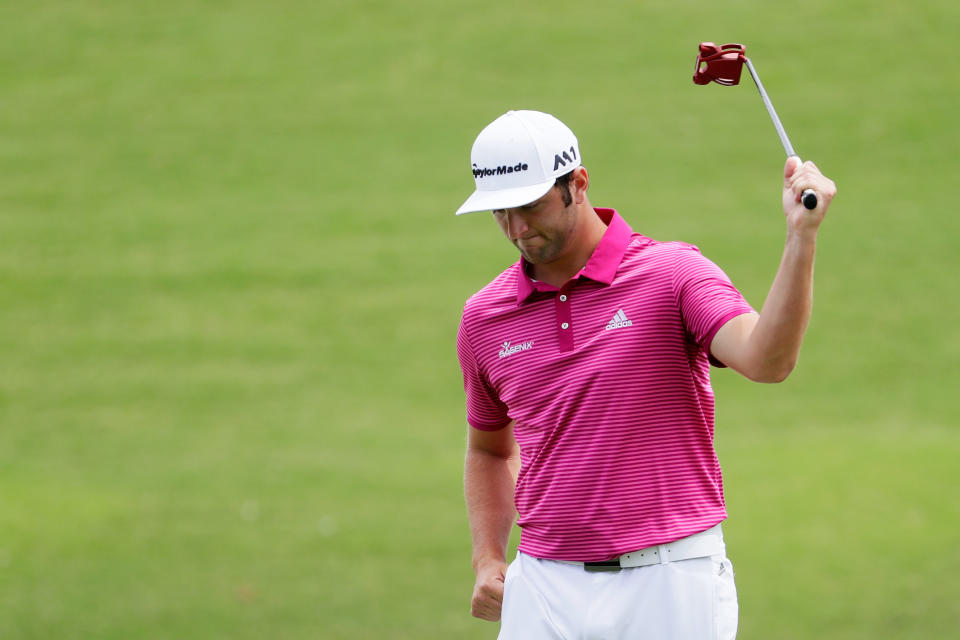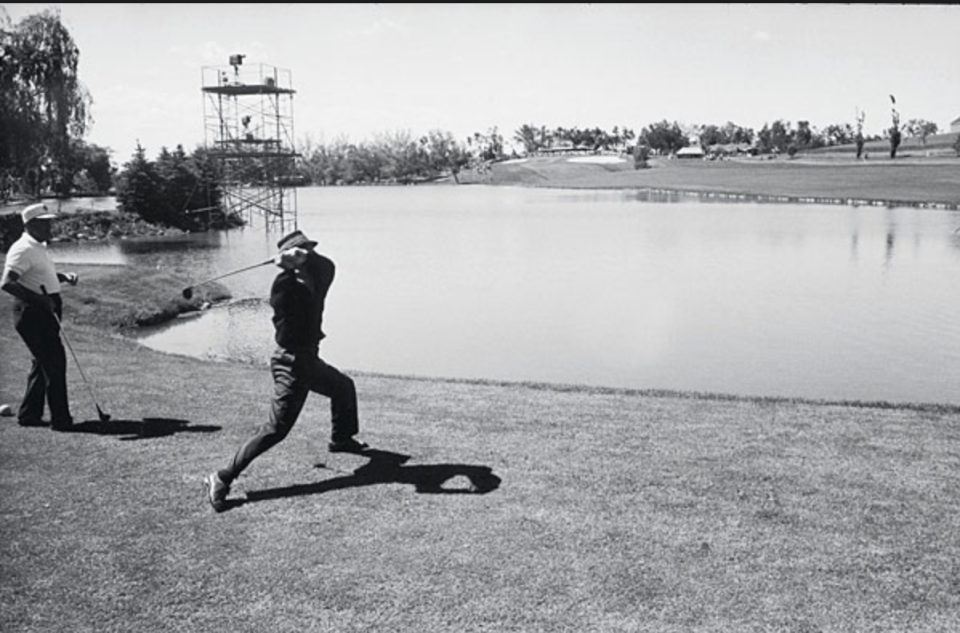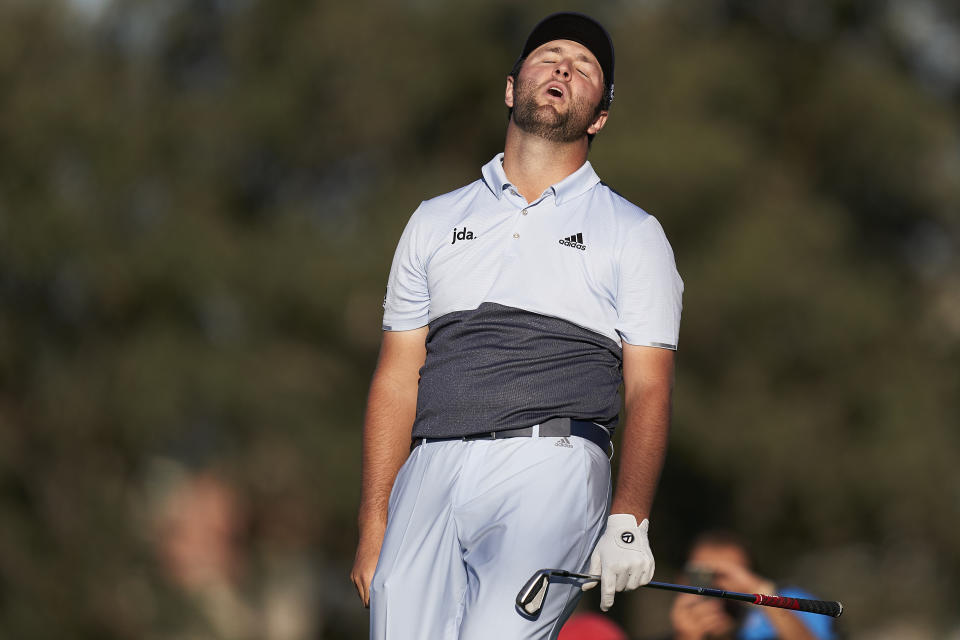How a volcanic temper affects golfers, from Jon Rahm to you
Scenes from an ongoing meltdown:
The US Open, 2017: Jon Rahm, 22 years old, is on the back nine at Erin Hills, deep in the clutches of a storm raging in his skull. It’s Friday, he’s speeding toward a missed cut, and he’s spiraling. With every botched approach and missed putt, he’s slamming clubs into the ground, punching signs, hurling expletives and clubs. It’s an ugly scene, but all too in character for Rahm, who’s already made quite a name for himself in less than a year as a pro.
The Players Championship, 2019: Rahm, now ranked 10th in the world, is tied for the lead on Sunday at Sawgrass when it all falls apart again. Already psychologically teetering, Rahm shakes off his caddy’s advice to lay up at the par-5 11th. Rahm instead tries to go for the green, ends up wet, curses until the TV broadcast cuts him off, and winds up losing a tournament he’d led coming into the day.
The Memorial, 2020: Rahm is leading the parade now, but his eight-shot lead is dwindling. At the 11th tee, he drifts his shot into a creek and reacts by slamming his club into the ground. His lead will shrink to as little as three with three holes left. But this time, he holds on to win and take over the No. 1 ranking in the world.

Rahm’s temper is a constant. Sometimes it’s a tremor, sometimes it’s a volcano, but it’s always there. This week, he’ll tee it up at the year’s first major as one of the top golfers in the world. How will he stand up to that scrutiny?
“I’ve been working on it really, really hard since 2014, and it’s a process,” Rahm said just before this year’s Players Championship. “With this being a work in progress, what people don’t see is the reason why I’m so happy now and one of the reasons why I’m so consistent and playing better, maybe one of the reasons why the bad weeks aren’t so bad. It’s very easy to translate what happens in real life onto the golf course, just because whatever happens outside is so much more important.” (He said those words just before the entire sports world shut down in March; he couldn’t have known how right he would prove to be.)
So have Rahm’s on-course explosions helped him reach the pinnacle of golf this year … or are they holding him back from reaching even greater heights in his career? According to experts in golf psychology, the answer is a little bit of both.

Temper on the course: causes and effects
“There is no place for temper in golf. It is an identity and character issue,” says Dr. David Cook, a specialist in the field of sport and performance psychology and the onetime mental training coach for the San Antonio Spurs, among many other clients. “When a game controls a person’s emotion rather than the person controlling their emotion, the game means too much. Temper is a willful choice that is neither good for the player, caddie, spectators or sport in general.”
“The game’s a great teacher if you listen to it,” says Jon Stabler, a golf mental coach and co-founder of the mental training program GolfPsych. “If you go out there and you’re losing it all the time, throwing clubs, and you don’t learn from that, you’re your own worst enemy.”
Even so, there’s a long and less-than-proud tradition of golfers absolutely losing their minds on Tour. One of the most famous (and relatable) photographs in golf history is that of Tommy Bolt slinging his club into a lake in the 1950s:

“Always throw clubs ahead of you,” Bolt, nicknamed “Thunder,” once said. “That way you won't waste any energy going back to pick them up.”
Since then, players from John Daly to Rory McIlroy have hurled clubs into nearby bodies of water. Tiger Woods has barked at galleries and photographers alike. Patrick Reed has run the gamut of expressions of temper, from chewing out photographers to snapping clubs over his knee. Temper tantrums may breach golf’s rules of decorum, but they’re at best a minor sin, since the only real victim is the tantrum-thrower himself.
“This game is diabolically hard,” says Stabler. “You can take that energy [from anger] in a game like football and use it, but in golf it’s a definite problem.”
The traditional take on golf is that it’s a player against the course, but that’s not completely true. It’s a player against themselves, a player against their own ability (or inability) to pull off a shot they know they’re capable of making. And that, says Dr. Joe Parent, is when matters can get tricky.
“In golf, when things don’t turn out the way you want, what can you get mad at?” says Parent, an author and performance psychologist whose clients have included Vijay Singh and Cristie Kerr. “You can get mad at your caddy. A lot of golfers use their caddy as their punching bag. You can get mad at the golf course, the architect, a phone going off in the crowd. But ultimately, in golf, who’s responsible? You are. What you get mad at is yourself.”
And therein lies the problem. A golfer can curse out a caddy — it’s part of their job description — or, in extreme circumstances, get a fan tossed. But you can’t get out of your own skull.
“Anger always carries with it a judgment about you or somebody else doing something wrong,” Parent says. “You have been wronged … That’s why people are angry a lot, because the world does not care about your personal preferences. The universe doesn’t listen when you complain.”
Oh, but golf fans sure do. Rahm has spent the last four years taking heat for his temper from fans on Twitter and golf commentators. The Golf Channel’s Brandel Chamblee called Rahm’s misfire at the Players “the most baffling decision ever struck here at this event,” and as Rahm unraveled at the Memorial last month, Nick Faldo just advised him to “chill.”
If only it were that easy.

How to ride the anger wave
Parent notes that there are three components to a temper tantrum on a golf course:
First, how far will you go? Will your tantrums stop at a muttered curse word, or will you go full Happy Gilmore and heave your entire bag into a lake?
Second, how long does it take you to hit that boiling point? Does it build up over a round, or are you glowing nuclear when you shank your opening drive at the first tee?
Finally, how do you express your rage? Do you bottle it up, or do you let it out into the world? Rahm has taken the latter option, and for him, it’s what works.
“I know golfers are supposed to try to internalize everything,” Rahm told Yahoo Sports at that U.S. Open back in 2017. “I wish I could. Every time I try to keep it to myself. Just imagine a Coca-Cola bottle. If you shake it once and it calms down. You shake it again and it calms down. Once you open it, it’s a complete mess. That’s what happens if I try to keep it down. If I try to keep it down, at some point I’m going to miss a shot that’s not that bad and I’m going to lose it. Sometimes I need to get mad.”
“He knows that to relax sometimes he has to let some of his anger out,” Phil Mickelson said after the Memorial. “He can’t hold that in. It might upset some people, but he knows that it allows him to be at his best.”
The key, observers say, is for Rahm not to get too comfortable with that anger. “When you learn to channel that emotion and that energy into focus, it can be helpful short-term, but it would not be a way to play the game every day,” Stabler says. “It would wear you out.”
“If you can control the energy [of anger], you can ride it and channel it,” Parent says. “How often have you seen a golfer have a bad hole and then smack the next drive right down the middle? They put some anger from the last hole into that one.”
The trick, Parent says, is to use both “focus and fire.” Commit to the moment, and use the intensity to power you. “There’s an old saying: You can’t stop the waves, but you can learn to surf,” he says. “Do the waves of anger overwhelm you, or can you ride on them?”
There’s also a physical component to temper tantrums. When you lose your cool, you literally become a different player.
“When you experience emotions, your body releases chemicals, including adrenaline, norepinephrine, cortisol, and glucose. These are all bad for your golf,” says Stabler. “These chemicals are starting a fight-or-flight response. They are literally changing our bodies — our big muscles get tighter, our brain gets busier, our touch and fine motor control diminishes.” He estimates that in the grips of a tantrum, a scratch golfer can fall to a 10 handicap.
Parent actually advises his clients, as they’re walking off the green, to physically mimic slamming a door, complete with grunt of frustration, as a symbolic gesture of putting distance between themselves and their frustration. (Try it. It really works.)
“It’s about releasing anger, not just suppressing it,” Parent says. “It’s in your rear view. Now, focus and fire on the next tee shot.”

How can Rahm use fire as fuel?
What does all this mean for Rahm? Both crisis and opportunity. For two weeks last month, he rose to the No. 1 ranking in the world. The question for Rahm is, did his temper help that rise, or is it holding him back from even further greatness?
Both Parent and Stabler stressed that Rahm is not a client, and they’re only offering observations from a distance. But their recommendations for him ran along similar lines.
“In my observation, his temper cost him the The Players [in 2019],” Parent says. “He made bad decisions out of anger. He may disagree, but his actions were that of someone watching his chance slip away.”
“Rahm, in a few interviews now, has said he is learning to be more accepting,” Stabler says. “He’s able to be more peaceful more of the time, and so as his performances are more successful, it will reinforce that. He’ll see how reacting emotionally is generally not going to help him.”
“Don’t let anger affect your decision making. That’s the main thing I would say to him,” Parent says. “Get angry and get over it. He’s gotten better. He’s gotten mentally tougher. He’s learning not to let the waves sweep him away. He’s learning to surf.”

_____
Jay Busbee is a writer for Yahoo Sports. Follow him on Twitter or contact him with tips and story ideas at jay.busbee@yahoo.com.
More from Yahoo Sports:


